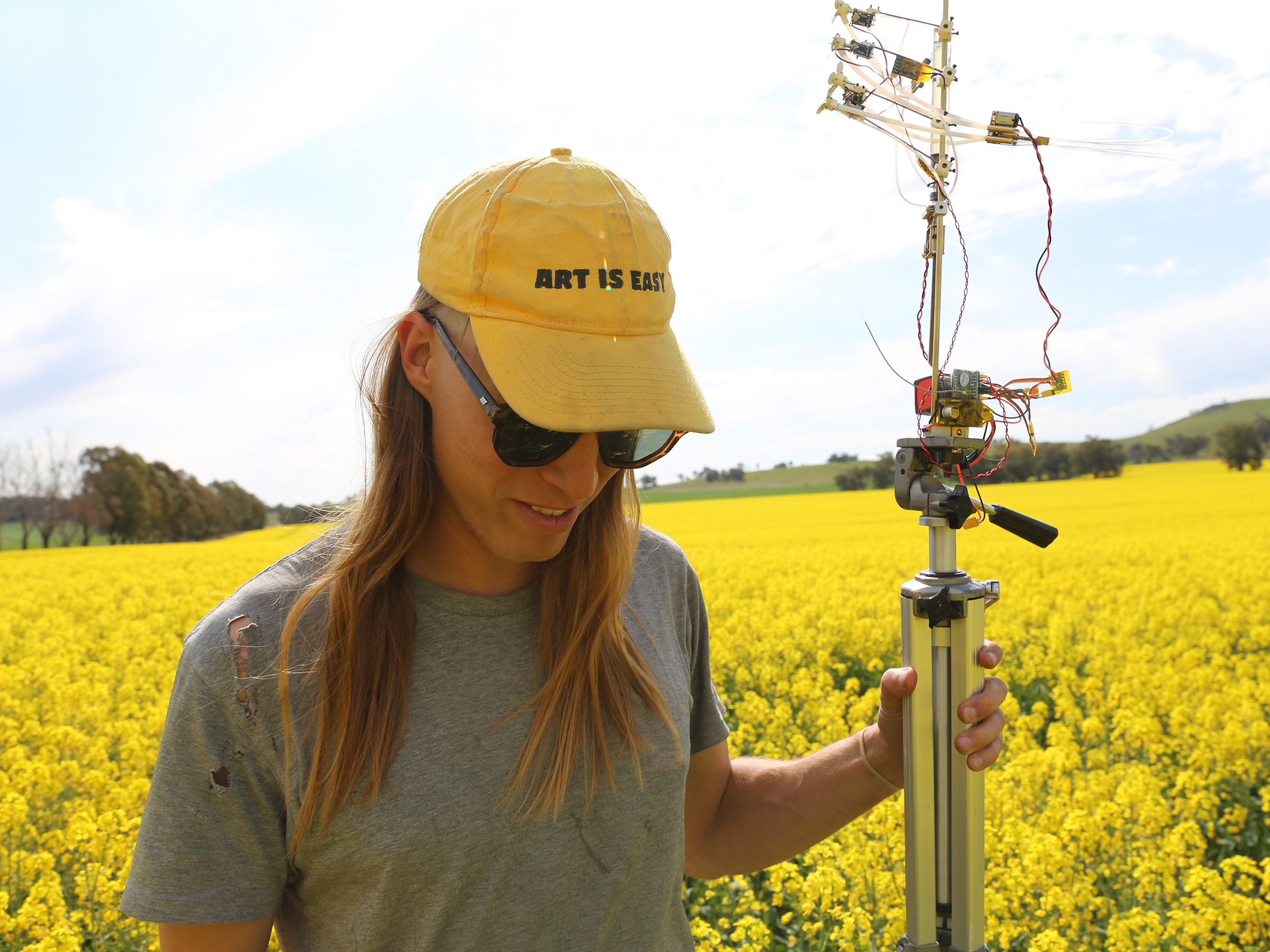Making Art for Bees
Michael Candy’s Synthetic Pollenizer is “a sculpture for a different species.”
When humans want to grab a bite to eat, they can raid the pantry, hop down to the corner store, or make a reservation at an expensive restaurant. When pollinating insects want a snack, they, too, choose among local plants. But for a few years, bees in Dookie, Victoria also had a fast-casual option: the Synthetic Pollenizer, a mechanical canola flower that serves up real nectar and pollen. The machine, made by artist Michael Candy, stood in a field in Dookie for part of last year. It’s designed to give bees an experience usually confined to the human realm, while letting humans in on a slightly more bee-like one.
Candy, who lives in Brisbane, specializes in creations that interact with their environments at various scales: his other works include a chair that “walks” with the help of the person sitting in it, and a public statue that weeps whenever a bombing occurs anywhere in the world. After spending time with field biologists at a conference a few years ago, he was inspired to make “a sculpture for a different species,” he explains. He began collaborating with some experts, including a beekeeper and a resource ecologist.

Scientists have long created artificial pollination devices to help them study bees. But, Candy explains, these tend to be “really boring flowers—just jars with holes with them.” The Synthetic Pollenizer is more of a multisensory bee experience, providing decor as well as nutrition. Canola pollen, which Candy purchases in bulk, courses from a repository up through a hose and ends up at a brass flower, where it is extruded by a “mechanical anther.” Meanwhile, nectar moves through a similar system and squirts out of the center of the flower. There’s even a surveillance element: When a bee visits, a small, motion-activated camera clicks on, and streams footage of the customer to YouTube.
When it’s placed in a field of natural canola, the Pollenizer is clearly an imposter. It looks like a “real” plant the same way that a fast food joint looks like a “real” restaurant: it’s got smoother surfaces, brighter colors, and more visible automation. While other flowers sway organically in the breeze, it stands stiff and still. And rather than being tucked demurely into stems and roots, its plumbing is clearly visible: gears twist, pistons fire, and pollen and nectar chug through tubes.

Still, it didn’t take too long for bees to get used to the new establishment. According to Candy’s rough estimate, they patronized the Pollenizer at about the same rate that they supped at real flowers. At times, Candy used peer pressure to give them a push: “With some of the prototypes, I’d even put a dead bee [on the fake flower] so that other bees could see how to land,” he says. “Once they know how to do it, they visit a lot more.”
Honeybees are facing a number of high-profile problems right now, including nutritional deficiencies, mites, and habitat loss. But Candy is quick to point out that the Pollenizer is not really meant to solve any of them: “Bees are very topical,” he says, “but that was never my focus.” Indeed, many advocates argue that the public focus on honeybee preservation actually distracts from more important conversations regarding native pollinator species.)
Instead, he’s just trying to see if it’s possible to slot a machine into an existing biological process without causing too much harm. He cites a Richard Brautigan poem that reads, in part, “I like to think…/ of a cybernetic forest/ filled with pines and electronics / where deer stroll peacefully / past computers / as if they were flowers.” “Agriculture is somewhere where technology is usually totally invasive,” he says. “[Pollination] works fine already, but I’m seeing if technology could actually be a part of this, non-invasively.”

Indeed, it’s bee-oriented to the degree that human viewers sometimes feel alienated. During a recent exhibition, a display Synthetic Pollenizer was shown alongside a livestream from the working one, which was positioned in a nearby field. “The curator sent me a message two days into the show and was like, ‘This [livestream] is really boring,’” Candy says. “And I was like, ‘Yeah!’… It’s not really catered for humans. It’s an interactive artwork for bees.”
As a human viewing the artwork, its power comes from realizing how many of the machines we’ve built don’t just affect our interactions with other species, but eliminate them entirely. “Beekeeping is so much fun,” Candy says, near the end of our conversation. “I really want to get a hive, but I live in a warehouse.” The robotic flower, too, is living in a box right now, he adds: “I don’t have a garden. I don’t know where I’d put it.”

































Follow us on Twitter to get the latest on the world's hidden wonders.
Like us on Facebook to get the latest on the world's hidden wonders.
Follow us on Twitter Like us on Facebook